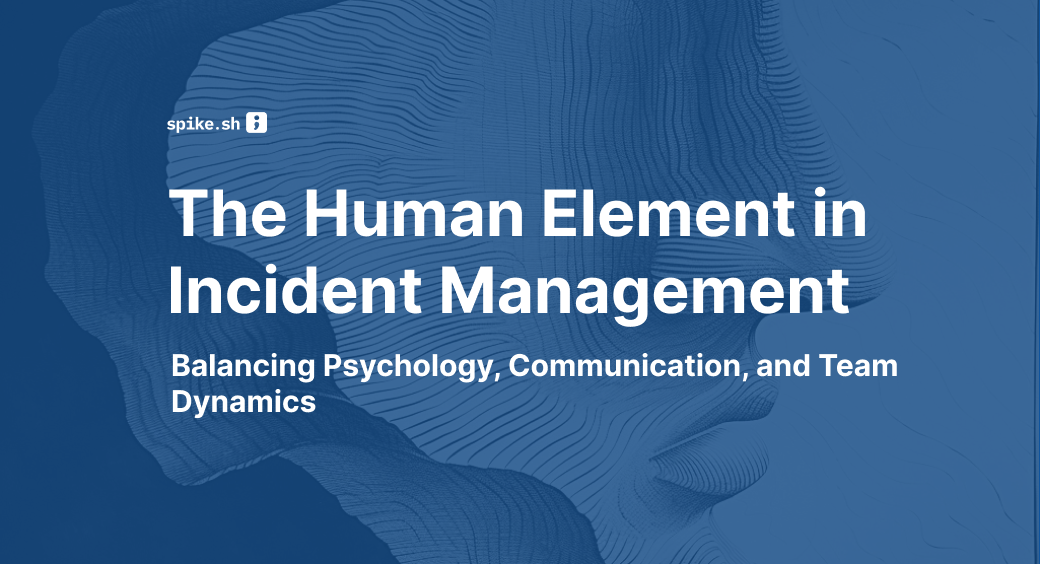Incident management isn't just about technology; it's about people too!
Understanding the human factors—psychology, communication, and team dynamics—is just as crucial.
Let's explore how these elements are essential in incident management.
The Role of Psychology in Incident Management
Picture this: Your team's in the middle of a critical system outage. The clock's ticking, customers complaining, and the pressure? It's through the roof.
This is when your team's mental game gets tested!
Now, dealing with these situations can be challenging, but it’s nothing your team can't handle.
The key? Set achievable goals, provide necessary tools and support, offer flexible schedules, and rotate on-call duties. Plus, encourage taking time off after a critical incident.
At Spike, we value balance and offer work modes like
Deep Work: For those times you need to focus, it keeps the minor alerts at bay.
Cooldown: Everyone needs a break, right? Take a break by offloading your duties to a colleague.
Out of Office: Going on a vacation or celebrating your kid’s birthday? A quick click and your responsibilities are covered.
Also, Spike automatically suppresses and logs repeat incidents. This reduces alert fatigue for your on-call team.
Communication: The Backbone of Incident Resolution
Effective communication is crucial in incident management. It’s needed to avoid escalating incidents.
Here are some challenges and solutions:
- Rapidly Changing Situations: Incidents can shift gears quickly, and keeping the team on the same page is challenging.
The game plan? Set up a war room for instant group calls to streamline communication and avoid misunderstandings. Combine this with clear protocols, real-time updates, regular briefings, and an Incident Command System for a structured response.
1. Remote or Distributed Teams: Different locations and time zones make communication tricky.
The fix? Use collaboration tools like Slack or Zoom, be time zone-conscious, embrace asynchronous communication, and maintain clear documentation. Plus, adopt the "Follow the Sun" approach—hand off duties to teams around the globe, each working their own sunny hours.
2. Silos within the Organization: Different departments have different communication styles, which can hinder collaboration.
The strategy? Create cross-functional teams, use unified communication channels, hold regular cross-departmental meetings, and align everyone with shared goals for incident response.
Recently, at Spike, we faced an SMS outage. We mobilized our team through automated phone calls in just 3 minutes. Then, we mapped out roles, kept our customers in the loop with ongoing updates, and swiftly resolved the issue in just 12 minutes.
This kind of efficient communication and rapid response is key to managing incidents effectively.
Team Dynamics and Collaboration in Incident Management
The composition and dynamics of your incident response team can significantly influence outcomes.
A well-balanced team, with a mix of technical expertise and soft skills, is ideal.
Leadership plays a pivotal role here. An effective leader not only provides direction but also fosters a sense of unity and purpose.
Collaboration is another critical factor. When team members share knowledge and work together seamlessly, incident resolution becomes more efficient.
Building this culture of collaboration involves regular team-building activities and an emphasis on shared goals.
Integrating Psychology, Communication, and Team Dynamics
When dealing with incidents, the key is to blend psychology, communication, and team dynamics seamlessly.
Think of it like a well-oiled machine where each part plays a vital role:
Psychology: Manages mental and emotional aspects, maintaining focus and resilience.
Communication: Ensures efficient and accurate information flow for quick decision-making.
Team Dynamics: Creates a collaborative environment, utilizing each member’s strengths.
By weaving these elements together, you can create a robust framework that not only addresses the technical aspects but also the human factors of incident management.
Wrap Up
In the end, it's the human elements—our ability to think, communicate, and collaborate—that often make the most significant difference in successfully managing incidents.
By emphasizing and nurturing these human aspects, you can ensure your team is not just technically adept but also psychologically ready and well-coordinated.
At Spike, we embrace a holistic approach, seamlessly integrating these key elements to build a strong, cohesive team that's prepared for any challenge.
This focus on the human side is what sets us apart in navigating the complexities of incident management.
Would like to see how Spike helps manage incidents? Sign up for a demo: https://spike.sh/demo

